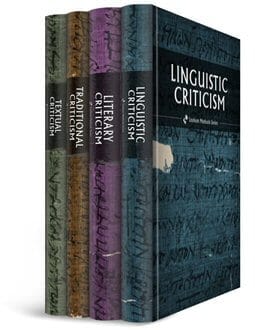There are translation differences, and there are source text differences. You know a source text difference when you see the notation “MT says” or “LXX says” in your Bible. These are the real differences in manuscripts. And unless you know what you’re looking at, they can be confusing, and perhaps even scary.
How do we trust that God’s Word has remained as he intended it? Textual criticism is the field of study that explores differences between biblical manuscripts and draws conclusions. It’s the field that determines the readings included in nearly all modern translations. It’s also the field behind all the challenging discussions about “biblical sources,” their “readings,” and their “vorlages” in Bible commentaries.
Few people work in this field of biblical studies nearly every day—our Bible scholars do. Their work in Lexham Methods Series: Textual Criticism, the first volume to be released in the series, makes textual criticism transparent and easy to understand. Learn about the technique, and grasp the terminology behind the very technical, but very important, work of discerning which biblical manuscript to translate and interpret.
Biblical interpretation guidance
The Lexham Methods Series combines the materials, hands-on practice, and guidance you would receive in a seminary class on Bible study methods. The series presents biblical interpretation, how-to instruction, and an annotated bibliography—showing real examples of the method in practice. It even includes professionally designed slides to help you share what you’ve learned.
Working through the Lexham Methods Series will allow you to:
- Grasp details about specific methods—Each volume provides an overview of a method, its major elements, the terminology involved, and examples of when and how the method is used.
- Learn how professional biblical study is done—This educational resource leads you through a self-study, with a how-to section and numerous examples. Whether you need a refresher or you’ve never studied biblical interpretation methods, this series is your guide.
- Share what you learn—Professionally designed slides highlight key terms, so you can present each method’s main ideas in a memorable way.
- Broaden and deepen your biblical education—Each volume presents key figures and moments in the historical development of the relevant type of biblical interpretation, all in clear and accessible writing.
- Get the most out of your Logos library—Links to the Logos library allow you to take your learning deeper.
Understand the work of Bible scholars, or get a refresher on the technical terminology. Make the most of your library: this series will explain to you how and why Bible scholars make the decisions they do. Learn how we got the texts our Bible translations are based on, how to interpret the differences, and so much more.
Pre-order Lexham Methods Series: Textual Criticism today.





